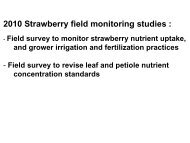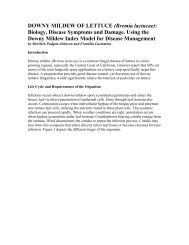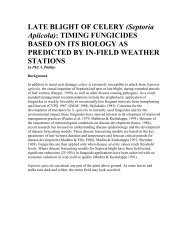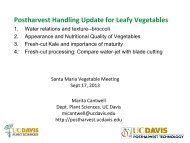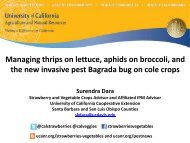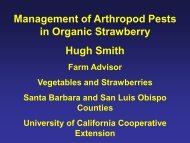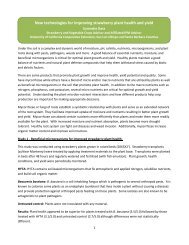Cultural Practices for Pest and Disease Management in Vegetables
Cultural Practices for Pest and Disease Management in Vegetables
Cultural Practices for Pest and Disease Management in Vegetables
You also want an ePaper? Increase the reach of your titles
YUMPU automatically turns print PDFs into web optimized ePapers that Google loves.
<strong>Pest</strong> <strong>Management</strong> <strong>in</strong> <strong>Vegetables</strong><br />
with <strong>Cultural</strong> <strong>Practices</strong><br />
Surendra Dara<br />
Strawberry <strong>and</strong> Vegetable Crops Advisor<br />
Santa Barbara <strong>and</strong> San Luis Obispo Counties<br />
UC Cooperative Extension
<strong>Cultural</strong> practices<br />
• Crop rotation<br />
• Cover crops<br />
• Cultivars<br />
• Cultivation<br />
• Plant<strong>in</strong>g<br />
• Irrigation<br />
• Sanitation<br />
• Nutrition<br />
wiley-caseih.com<br />
solufeed.com<br />
fws.gov<br />
ipm.iastate.edu
Crop rotation<br />
• Rotate with unrelated or non-susceptible hosts<br />
• Rotate with resistant cultivars<br />
• Rotate with green manure crops
Crop rotation<br />
• Breaks pest cycles<br />
Verticillium wilt <strong>in</strong> tomatoes<br />
Rotate with broccoli<br />
Root knot nematodes<br />
<strong>in</strong> lettuce<br />
Rotate with resistant tomato or<br />
bean cultivars
Crop rotation<br />
• Recycles nutrients
Crop rotation<br />
• Enhances soil quality<br />
– Ma<strong>in</strong>ta<strong>in</strong>s balance between the accumulation <strong>and</strong><br />
decomposition of organic matter<br />
– Improves soil structure<br />
– Prevents erosion
Cover crops<br />
• Weed suppression<br />
• Attract natural enemies<br />
• Improved water penetration<br />
African cowpea <strong>for</strong> tomato weed management<br />
Cali<strong>for</strong>nia Farm Bureau Federation<br />
• Increased microbial activity<br />
• Increased nutrients
Cultivars<br />
• <strong>Disease</strong> <strong>and</strong> pest resistant varieties<br />
– Tomato cultivars HMX 4801, U 567, UGX 10405, DRI<br />
8058 are resistant to Fusarium wilt, Verticillum wilt,<br />
bacterial speck, spotted wilt <strong>and</strong> root knot nematode.<br />
– Glossy cultivars of certa<strong>in</strong> crucifers with reduced wax<br />
are resistant to diamondback moth<br />
• Early or late matur<strong>in</strong>g varieties to avoid the<br />
severity of pest <strong>in</strong>cidence.
Cultivation<br />
• Thorough cultivation to manage pests <strong>and</strong> weeds<br />
Liriomyza leafm<strong>in</strong>er damage <strong>in</strong> sp<strong>in</strong>ach<br />
tay<strong>for</strong>th.co.uk
Irrigation<br />
• Type of irrigation <strong>in</strong>fluences pest occurrence<br />
Thrips on onion<br />
Bulb mite on onion<br />
Bacterial soft rot
Irrigation<br />
• Amount of irrigation<br />
Pythium aphanidermatum<br />
bsu.edu<br />
• Allow<strong>in</strong>g foliage to dry between irrigations<br />
Pepper<br />
apsnet.org<br />
• Higher beds <strong>in</strong> heavier<br />
soils <strong>for</strong> good dra<strong>in</strong>age<br />
Downy mildew of cauliflower
Plant<strong>in</strong>g<br />
• Quality seeds <strong>and</strong> transplants<br />
• Plant beds<br />
• Location<br />
• Time<br />
Downy mildew <strong>in</strong> broccoli
Sanitation<br />
• Removal of weeds <strong>and</strong> crop residue<br />
– Broad mites <strong>and</strong> aphids on peppers <strong>and</strong> crown root<br />
aphids <strong>in</strong> carrots<br />
– Thrips <strong>in</strong> tomatoes <strong>and</strong> peppers after harvest<strong>in</strong>g<br />
radhicchio<br />
• Sanitation of the field equipment<br />
– Basal rot transmitted through contam<strong>in</strong>ated<br />
equipment<br />
Broad mites on peppers<br />
APS Press<br />
Crown root aphids on carrots UC IPM
Soil amendment<br />
• Amend soil to ma<strong>in</strong>ta<strong>in</strong> optimal conditions<br />
required <strong>for</strong> the crop<br />
-Club root of broccoli<br />
-Colorado potato beetle<br />
Club root of broccoli<br />
Colorado potato beetle
Nutrition<br />
• Abiotic disorders<br />
• Attract pests <strong>and</strong> promote weed growth<br />
• Weaker plants more susceptible to pests<br />
<strong>and</strong> diseases<br />
Cabbage tipburn umassvegetable.org
Conclusions<br />
• Simple cultural practices can have major<br />
impact on diseases <strong>and</strong> pests<br />
• Choose the practices best suited <strong>for</strong> the<br />
situation
Thank you<br />
Questions?





